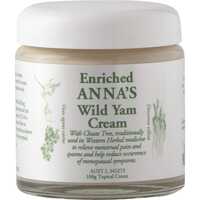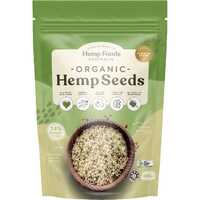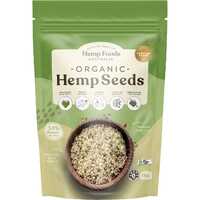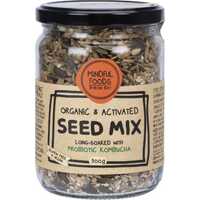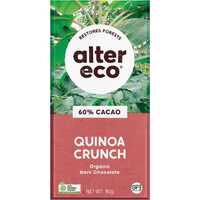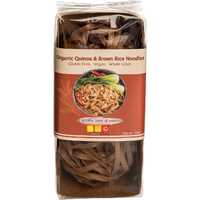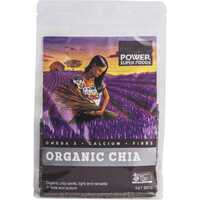We have access to more healthy foods than ever before. Traditional ingredients are shipped between continents on a daily basis, with exotic textures and flavours widely available through online retailers. Quinoa is one food that has captured the world's attention over recent years. Consumed as tiny seeds in a variety of colours, it's a big hit with health enthusiasts across the world. Easy to grow and packed with beneficial nutrients, quinoa is the epitome of the modern-day superfood.
In this article, we'll take a long look at quinoa and its many benefits. We'll review the history of this unique plant, look at different types of quinoa, and show you how to integrate it into your diet.
What Exactly is Quinoa?
Pronounced "keen-wah", quinoa is a plant, gluten-free wholegrain, and edible seed. The quinoa plant is a flowering member of the amaranth family, and it's grown mostly for its seeds. These tiny seeds come in a variety of colours, including black, red, yellow, and white. The quinoa plant has been cultivated for around 7,000 years, originally in the Andean region of South America. From Ecuador and Chile to Bolivia and Peru, it has long been part of the South American diet.
Quinoa seeds may be very small, but they have a higher nutritional value than other cereals. Along with nutrient density, seeds from this plant enjoy an unusual composition and exceptional balance. For example, while quinoa is primarily a carbohydrate, it also has lots of oil, protein and fat. Quinoa is the perfect "functional food", which is a more toned-down version of the "superfood" label.
This versatile ingredient is popular in cereals and smoothies, and it works well in sweet or savoury dishes. Unlike some other superfood products, it's easy to integrate into your daily diet. Quinoa has a chewy texture and nutty flavour, with a slight earthy aftertaste. It has been compared to brown rice or couscous, and it's often used as an alternative to these ingredients. With its rich nutrient profile, compact size, and mild taste, quinoa is the perfect modern ingredient.
A Short History of Quinoa
Quinoa is a fairly recent addition to the Western diet, but it's been cultivated in South America for 7,000 years and possibly longer. The original variant of this plant is Chenopodium quinoa Willd, a stress-tolerant Amaranthacean cultivated along the Andes in a range of challenging conditions. From the plains of Chile to 4,500 m above sea level in Bolivia, this versatile plant passed through several genetic events before it spread across the world.
Modern quinoa is a hybrid of various ancestors, with the plant domesticated at different times and places by local people. It was probably domesticated twice in the early days, first in the high Andes and then in the Chilean and Argentinean lowlands. The history of quinoa was also affected by colonisation, with the Spanish conquest of South America slowing down the plant's spread. Traditional quinoa plants were replaced by maize in many areas, as they were easier to farm, cheaper to process, and more familiar to Spanish rulers.
Quinoa never went away, however. It evolved in line with local populations. Humans had a huge influence on the plant's distribution, with quinoa adapting over time to suit new environments, altitudes, and salinity levels. While quinoa didn't have the same commercial appeal as maize and wheat crops in South America, its adaptability made it perfect for global cultivation. Quinoa is now grown all over the world, from the United States to Europe and even Tasmania. The health revolution of the late 20th century turned more people onto quinoa, and it's become one of the most popular superfoods in the world.
Types of Quinoa
Due to its complex history of domestication, more than 3,000 varieties of quinoa are now grown across the world. Most of these variants are classified according to their colour. The most widely grown types are red, black, and white, and you can also buy yellow and even tri-colour varieties:
- White quinoa - Sometimes called ivory quinoa, this is the most common variety. White seeds are less bitter than red or black seeds, and they're also lighter and less chewy. White quinoa can be used as a rice replacement, and it works great in salads, stir-fries, and baked products.
- Red quinoa - As the second most common variety, red quinoa is almost as versatile as white quinoa. While these seeds aren't great for baked goods or other sweet dishes, they're fantastic in salads or as a rice replacement. Red quinoa has a nutty flavour and crunchy texture, which makes it perfect for grain bowls.
- Black quinoa - This type of quinoa isn't as common as white or red varieties, but it's even more healthy. Black quinoa has a higher concentration of protein and dietary fibre, along with less fat content and a delicious nutty taste. It also has a chewier texture, which makes it ideal for cold dishes like salads.
- Yellow quinoa - This variety is probably the least common form of quinoa on this list. It's also called golden or tan quinoa, and it's very similar to the standard white variant. Red quinoa also has its variants, with purple and orange seeds regularly seen across South America.
- Tri-colour quinoa - Also known as rainbow quinoa for obvious reasons, this variety is a blend of white, red, and black quinoa. While it's not really a separate variety, tri-colour quinoa looks fantastic in salads, cereals, and porridge dishes.
Along with colour, quinoa is also categorised according to its form. While most products are sold as seeds, quinoa can also be rolled into flakes or ground into flour. These forms of quinoa are meant for cooking and baking, and they're available from many supermarkets and health food retailers. Quinoa flour is 100% gluten-free, and its texture is ideal for making delicious baked goods.
The Nutritional Profile of Quinoa
Quinoa has a balanced nutritional profile that includes protein, carbohydrates, fat, fibre, vitamins, and minerals. It's often called a "superfood", as it packs lots of nutritional goodness into a very tiny space. This versatile seed is a complete source of plant-based protein, as it contains all nine essential amino acids. This is rare for plant-based foods, which explains why quinoa is such a hit with vegetarians and vegans. Quinoa has 8 grams of protein and 5 grams of fibre per cup, which is much more than rice and other common carbohydrates.
All in all, quinoa is 32-60% starchy carbohydrate, 10-18% protein, and 4.4-8.8% fat. Carbohydrates provide immediate energy, and protein helps to build and maintain your body. In terms of micronutrients, quinoa is a rich source of essential minerals like manganese, phosphorus, and magnesium, along with essential vitamins such as folate and thiamine. According to the Reference Daily Intake quotas used in the United States and Canada, 100 grams of quinoa provides 46% Daily Value (DV) of folate, 55% DV of magnesium, 65% DV of phosphorus, 33% DV of zinc, and 20% DV or higher of protein and dietary fibre.
Quinoa also contains various plant compounds, many of which act as powerful antioxidants. This versatile food contains a number of bioactive phytochemicals, including high concentrations of quercetin, kaempferol, and other beneficial flavonoids and carotenoids. These phytochemicals contribute to the antioxidant activity of quinoa, delivering health benefits in combination with a balanced diet.
These ingredients offer protection against a variety of chronic conditions, including heart disease, diabetes, and several cancers.
Different quinoa types have their own nutritional profiles, at least to some degree. While all forms of quinoa have the same basic protein content, fat content can differ between types along with specific micronutrients such as vitamin E. According to one study into red, black, and white quinoa, black seeds had the lowest overall fat content and the highest amount of healthy omega-3 fatty acids. In the same study, red and black quinoa were found to have nearly twice the vitamin E content of white quinoa, and darker varieties were associated with more antioxidant capacity.
How to Enjoy Quinoa
There are lots of ways to get quinoa into your daily diet. From early-morning cereals to late-night sweets, this superfood sensation can be added to a wide array of snacks and dishes:
- Cereals - Whether you make your own granola from scratch or add extras to a commercial blend, quinoa makes your breakfast crunchier, tastier, and much healthier. Darker quinoa seeds generally provide more morning crunch.
- Salads - If you struggle getting enough leafy greens into your diet, quinoa and other healthy seeds are the perfect solution. With their crunchy texture and nutty taste, you'll enjoy salads like never before.
- Snacks - Quinoa is included in many commercial health food snacks, such as bars, bites, and balls. It's often included with other seeds and nuts, turning any snack into a healthy and gratifying superfood.
- Meals - Quinoa is the perfect alternative to rice, couscous, and pasta. It provides the same carbohydrate fullness and energetic goodness as these ingredients but in a much healthier package.
- Smoothies - Quinoa is fantastic in shakes and smoothies. It adds just the right amount of texture, it tastes great with fruits and vegetables, and it's capable of transforming your favourite liquid snack into a satisfying meal.
If you want to get more quinoa into your diet, Healthy Being is here to help. From flour and flakes to healthy seeds and snacks, we have all the quinoa you need in one convenient location. Check out our huge range of products today or contact our friendly team to learn more.


 Certified Organic
Certified Organic Vegan Friendly
Vegan Friendly  Vegetarian
Vegetarian Organic Ingredients
Organic Ingredients Dairy Free
Dairy Free Gluten Free
Gluten Free Keto Friendly
Keto Friendly

















